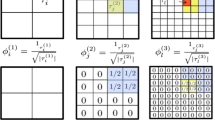Abstract
The standard approach to image reconstruction is to stabilize the problem by including an edge-preserving roughness penalty in addition to faithfulness to the data. However, this methodology produces noisy object boundaries and creates a staircase effect. The existing attempts to favor the formation of smooth contour lines take the edge field explicitly into account; they either are computationally expensive or produce disappointing results. In this paper, we propose to incorporate the smoothness of the edge field in an implicit way by means of an additional penalty term defined in the wavelet domain. We also derive an efficient half-quadratic algorithm to solve the resulting optimization problem. Numerical experiments show that our technique preserves edge sharpness while smoothing contour lines; it produces visually pleasing reconstructions which are quantitatively better than the results obtained without wavelet domain constraints.
Preview
Unable to display preview. Download preview PDF.
Similar content being viewed by others
References
Geman, D., Reynolds, G.: Constrained restoration and the recovery of discontinuities. IEEE Trans. Pattern Anal. Machine Intell. 14(3), 367–383 (1992)
Charbonnier, P., Blanc-Féraud, L., Aubert, G., Barlaud, M.: Deterministic edge-preserving regularization in computed imaging. IEEE Trans. Image Processing 6(2), 298–311 (1997)
Delaney, A.H., Bresler, Y.: Globally convergent edge-preserving regularized reconstruction: an application to limited-angle tomography. IEEE Trans. Image Processing 7(2), 204–221 (1998)
Nikolova, M., Idier, J., Mohammad-Djafari, A.: Inversion of large-support ill-posed linear operators using a piecewise Gaussian MRF. IEEE Trans. Image Processing 7(4), 571–585 (1998)
Robini, M.C., Rastello, T., Magnin, I.E.: Simulated annealing, acceleration techniques and image restoration. IEEE Trans. Image Processing 8(10), 1374–1387 (1999)
Marroquin, J., Mitter, S., Poggio, T.: Probabilistic solution of ill-posed problems in computational vision. J. Amer. Statist. Assoc. 82(397), 76–89 (1987)
Bertero, M., Poggio, T.A., Torre, V.: Ill-posed problems in early vision. Proc. IEEE 76(8), 869–889 (1988)
Geman, S., Geman, D.: Stochastic relaxation, Gibbs distributions, and the Bayesian restoration of images. IEEE Trans. Pattern Anal. Machine Intell. 6(6), 721–741 (1984)
Demoment, G.: Image reconstruction and restoration: overview of common estimation structures and problems. IEEE Trans. Acoust., Speech, Signal Processing 37(12), 2024–2036 (1989)
Green, P.J.: Bayesian reconstructions from emission tomography data using a modified EM algorithm. IEEE Trans. Med. Imag. 9(1), 84–93 (1990)
Lange, K.: Convergence of EM image reconstruction algorithms with Gibbs priors. IEEE Trans. Med. Imag. 9(4), 439–446 (1990)
Bouman, C., Sauer, K.: A generalized Gaussian image model for edge-preserving MAP estimation. IEEE Trans. Image Processing 2(3), 296–310 (1993)
Stevenson, R.L., Schmitz, B.E., Delp, E.J.: Discontinuity preserving regularization of inverse visual problems. IEEE Trans. Syst., Man, Cybern. 24(3), 455–469 (1994)
Li, S.Z.: On discontinuity-adaptive smoothness priors in computer vision. IEEE Trans. Pattern Anal. Machine Intell. 17(6), 576–586 (1995)
Geman, S., McClure, D.E.: Statistical methods for tomographic image reconstruction. Bull. Int. Stat. Inst. 52, 5–21 (1987)
Hebert, T., Leahy, R.: A generalized EM algorithm for 3-D Bayesian reconstruction from Poisson data using Gibbs priors. IEEE Trans. Med. Imag. 8(2), 194–202 (1989)
Geman, D., Yang, C.: Nonlinear image recovery with half-quadratic regularization. IEEE Trans. Image Processing 4(7), 932–946 (1995)
Nikolova, M.: Markovian reconstruction using a GNC approach. IEEE Trans. Image Processing 8(9), 1204–1220 (1999)
Nikolova, M.: Analysis of the recovery of edges in images and signals by minimizing nonconvex regularized least-squares. SIAM J. Multiscale Model. Simul. 4(3), 960–991 (2005)
Bedini, L., Benvenuti, L., Salerno, E., Tonazzini, A.: A mixed-annealing algorithm for edge preserving image reconstruction using a limited number of projections. Signal Process 32(3), 397–408 (1993)
Blanc-Féraud, L., Teboul, S., Aubert, G., Barlaud, M.: Nonlinear regularization using constrained edges in image reconstruction. In: Proc. IEEE Int. Conf. Image Processing, Lausanne, Switzerland, September 1996, vol. 2, pp. 449–452 (1996)
Idier, J.: Convex half-quadratic criteria and interacting auxiliary variables for image restoration. IEEE Trans. Image Processing 10(7), 1001–1009 (2001)
Dobson, D., Santosa, F.: Recovery of blocky images from noisy and blurred data. SIAM J. Appl. Math. 56(4), 1181–1198 (1996)
Chang, T., Marquina, A., Mulet, P.: High-order total variation-based image restoration. SIAM J. Sci. Comput. 22(2), 503–516 (2000)
Yaou, M.H., Chang, W.T.: Fast surface interpolation using multiresolution wavelet transform. IEEE Trans. Pattern Anal. Machine Intell. 16(7), 673–688 (1994)
Cohen, A., Daubechies, I., Feauveau, J.C.: Biorthogonal bases of compactly supported wavelets. Comm. Pure Appl. Math. 45(5), 485–560 (1992)
Belge, M., Kilmer, M.E., Miller, E.L.: Efficient determination of multiple regularization parameters in a generalized L-curve framework. Inverse Problems 18(4), 1161–1183 (2002)
Ramani, S., Blu, T., Unser, M.: Monte-Carlo SURE: a black-box optimization of regularization parameters for general denoising algorithms. IEEE Trans. Image Processing 17(9), 1540–1554 (2008)
Author information
Authors and Affiliations
Editor information
Editors and Affiliations
Rights and permissions
Copyright information
© 2009 Springer-Verlag Berlin Heidelberg
About this paper
Cite this paper
Robini, M.C., Viverge, PJ., Zhu, YM., Magnin, I.E. (2009). Edge-Preserving Image Reconstruction with Wavelet-Domain Edge Continuation. In: Kamel, M., Campilho, A. (eds) Image Analysis and Recognition. ICIAR 2009. Lecture Notes in Computer Science, vol 5627. Springer, Berlin, Heidelberg. https://doi.org/10.1007/978-3-642-02611-9_2
Download citation
DOI: https://doi.org/10.1007/978-3-642-02611-9_2
Publisher Name: Springer, Berlin, Heidelberg
Print ISBN: 978-3-642-02610-2
Online ISBN: 978-3-642-02611-9
eBook Packages: Computer ScienceComputer Science (R0)




